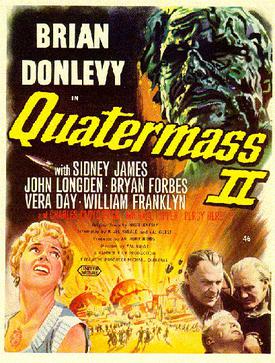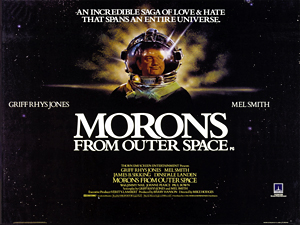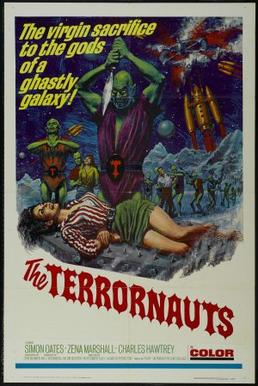
Starman is a 1984 American science fiction romance drama film directed by John Carpenter that tells the story of a non-corporeal alien who has come to Earth and cloned a human body in response to the invitation found on the gold phonograph record installed on the Voyager 2 space probe. The original screenplay was written by Bruce A. Evans and Raynold Gideon, with Dean Riesner making uncredited re-writes.

Attack of the 50 Foot Woman is a 1958 independently made American science fiction horror film directed by Nathan H. Juran and starring Allison Hayes, William Hudson and Yvette Vickers. It was produced by Bernard Woolner. The screenplay was written by Mark Hanna, and the original music score was composed by Ronald Stein. The film was distributed in the United States by Allied Artists as a double feature with War of the Satellites.
Amicus Productions was a British film production company, based at Shepperton Studios, England, active between 1962 and 1977. It was founded by American producers and screenwriters Milton Subotsky and Max Rosenberg.

Quatermass 2 is a 1957 black-and-white British science fiction horror film drama from Hammer Film Productions. It was originally released in the UK as Quatermass II and was produced by Anthony Hinds, directed by Val Guest, and stars Brian Donlevy with co-stars John Longden, Sidney James, Bryan Forbes, Vera Day, and William Franklyn. Quatermass 2 is a sequel to Hammer's earlier film The Quatermass Xperiment (1955). Like its predecessor, it is based on the BBC Television serial Quatermass II written by Nigel Kneale. Brian Donlevy reprises his role as the eponymous Professor Bernard Quatermass, making him the only actor to play the character twice in a film. It is often erroneously considered as the first film sequel to use the '2' / 'II' suffix within the title, though this distinction belongs to Sanshiro Sugata Part II.

Lifeforce is a 1985 British science fiction horror film directed by Tobe Hooper, adapted by Dan O'Bannon and Don Jakoby, and starring Steve Railsback, Peter Firth, Frank Finlay, Mathilda May, and Patrick Stewart. Based on Colin Wilson's 1976 novel The Space Vampires, the film portrays the events that unfold after a trio of humanoids in a state of suspended animation are brought to Earth after being discovered in the hold of an alien space ship by the crew of a European Space Shuttle.

It Came from Outer Space is a 1953 American science fiction horror film, the first in the 3D process from Universal-International. It was produced by William Alland and directed by Jack Arnold. The film stars Richard Carlson and Barbara Rush, and features Charles Drake, Joe Sawyer, and Russell Johnson. The script is based on Ray Bradbury's original film treatment "The Meteor" and not, as sometimes claimed, a published short story.

Inseminoid is a 1981 British science fiction horror film directed by Norman J. Warren and starring Judy Geeson, Robin Clarke and Stephanie Beacham, along with Victoria Tennant in one of her early film roles. The plot concerns a team of archaeologists and scientists who are excavating the ruins of an ancient civilisation on a distant planet. One of the women in the team (Geeson) is impregnated by an alien creature and taken over by a mysterious intelligence, driving her to murder her colleagues one by one and feed on them.

Slither is a 2006 science fiction comedy horror film written and directed by James Gunn in his directorial debut. Produced by Paul Brooks and Eric Newman, the film stars Nathan Fillion, Elizabeth Banks, Tania Saulnier, Gregg Henry, and Michael Rooker. The film is set in a small town in South Carolina that becomes invaded by a malevolent alien parasite.

Dreamcatcher is a 2003 American science fiction horror film based on Stephen King's 2001 novel of the same name. Directed by Lawrence Kasdan and co-written by Kasdan and screenwriter William Goldman, the film stars Thomas Jane, Jason Lee, Damian Lewis and Timothy Olyphant as four friends who encounter an invasion of parasitic aliens. It also features Morgan Freeman, Tom Sizemore and Donnie Wahlberg.

Aliens vs. Predator: Requiem is a 2007 American science fiction action film starring Steven Pasquale, Reiko Aylesworth, John Ortiz, Johnny Lewis and Ariel Gade. The directorial debut of The Brothers Strause, the film was written by Shane Salerno and is a direct sequel to Alien vs. Predator (2004) as well as the second and latest installment in the Alien vs. Predator franchise, the sixth film in the Alien franchise and the fourth film in the Predator franchise, continuing the crossover between the Alien and Predator franchises.

The Body Snatchers is a science fiction novel by American writer Jack Finney, originally serialized in Collier's magazine in November–December 1954 and published in book form the following year.

Morons from Outer Space is a 1985 British comedy-science fiction film directed by Mike Hodges and written by and starring Griff Rhys Jones and Mel Smith. It also stars Jimmy Nail and James B. Sikking.

The Terrornauts is a 1967 British science fiction film directed by Montgomery Tully and starring Simon Oates and Zena Marshall. It was produced by Amicus Productions and based on the 1960 novel The Wailing Asteroid by Murray Leinster, adapted for screen by John Brunner. Space scientists foil an alien invasion of Earth.

Night Caller from Outer Space, is a British 1965 science fiction film directed by John Gilling and starring John Saxon, Maurice Denham and Patricia Haines. It is based on Frank Crisp's 1961 novel The Night Callers. A colourised version of the film was released in 2011.

Alien Trespass is a 2009 science-fiction comedy film based on 1950s sci-fi B movies, produced by James Swift and directed by R.W. Goodwin. It stars Eric McCormack and Robert Patrick. The film was shot in Ashcroft, British Columbia.

Alien is a 1979 science fiction horror film directed by Ridley Scott and written by Dan O'Bannon. Based on a story by O'Bannon and Ronald Shusett, it follows the crew of the commercial space tug Nostromo, who, after coming across a mysterious derelict spaceship on an uncharted planetoid, find themselves up against a deadly and aggressive extraterrestrial loose within their vessel. The film stars Tom Skerritt, Sigourney Weaver, Veronica Cartwright, Harry Dean Stanton, John Hurt, Ian Holm, and Yaphet Kotto. It was produced by Gordon Carroll, David Giler, and Walter Hill through their company Brandywine Productions and was distributed by 20th Century-Fox. Giler and Hill revised and made additions to the script; Shusett was the executive producer. The Alien and its accompanying artifacts were designed by the Swiss artist H. R. Giger, while concept artists Ron Cobb and Chris Foss designed the more human settings.

Sting of Death is a 1965 American science fiction horror film directed by William Grefé, written by Al Dempsey, and starring Joe Morrison, Valerie Hawkins, Deanna Lund, John Vella, and Jack Nagle. Its plot concerns five female college students who head to the Florida Everglades for a holiday, but instead of fun in the sun, run into trouble with a mutated, bloodthirsty, and quite deadly jellyfish-man-monster.

Attack the Block is a 2011 British science fiction comedy horror film written and directed by Joe Cornish and starring John Boyega, Jodie Whittaker, and Nick Frost. Its storyline centres on a teenage street gang who have to defend themselves from predatory alien invaders on a council estate in South London on Guy Fawkes Night. It was the film debut of Cornish, Boyega, and composer Steven Price.

The Cosmic Man is a 1959 independently made black-and-white science fiction film, directed by Herbert S. Greene and produced by Robert A. Terry. The film stars John Carradine, Bruce Bennett and Angela Greene. The narrative concerns an extraterrestrial being who, just as the space age is beginning, comes to Earth bearing a message of interplanetary peace and understanding, only to clash with the military. The Cosmic Man was made by Futura Productions Inc. and was distributed in the US by Allied Artists and in the UK by Associated British-Pathé.

Astro Kid is a 2019 French animated science-fiction film directed and written by Éric Tosti with the participation of the co-writers David Alaux and Jean-François Tosti. The plot concerns on a young boy named Willy, who after the destruction of his ship, gets separated from his parents and lands on an unexplored planet, where he must survive until the arrival of a rescue mission.



















